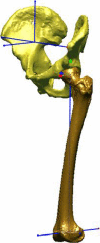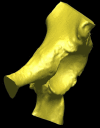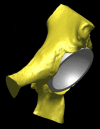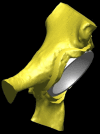Does acetabular retroversion affect range of motion after total hip arthroplasty?
- PMID: 20665139
- PMCID: PMC3008864
- DOI: 10.1007/s11999-010-1482-6
Does acetabular retroversion affect range of motion after total hip arthroplasty?
Abstract
Background: Increasingly, acetabular retroversion is recognized in patients undergoing hip arthroplasty. Although prosthetic component positioning is not determined solely by native acetabular anatomy, acetabular retroversion presents a dilemma for component positioning if the surgeon implants the device in the anatomic position.
Questions/purposes: We asked (1) whether there is a difference in ROM between surface replacement arthroplasty (SRA) and THA in the retroverted acetabulum, and (2) does increased femoral anteversion improve ROM in the retroverted acetabulum?
Methods: Using a motion analysis tracking system, we determined the ROM of eight cadaveric hips and then created virtual CT-reconstructed bone models of each specimen. ROM was determined with THA and SRA systems virtually implanted with (1) the acetabular component placed in 45° abduction and matching the acetabular anteversion (average 23° ± 4°); (2) virtually retroverting the bony acetabulum 10°; and (3) after anteverting the THA femoral stem 10°.
Results: SRA resulted in ROM deficiencies in four of six maneuvers, averaging 25% to 29% in the normal and retroverted acetabular positions. THA restored ROM in all six positions in the normal acetabulum and in four of the six retroverted acetabula. The two deficient positions averaged 5% deficiency. THA with increased femoral stem anteversion restored ROM in five positions and showed only a 2% deficiency in the sixth position. Compared with the intact hip, ROM deficits were seen after SRA in the normal and retroverted acetabular positions and to a lesser extent for THA which can be improved with increased femoral stem anteversion.
Conclusion: Poor ROM may result after SRA if acetabular retroversion is present.
Figures










Similar articles
-
Modular necks improve the range of hip motion in cases with excessively anteverted or retroverted femurs in THA.Clin Orthop Relat Res. 2010 Dec;468(12):3342-7. doi: 10.1007/s11999-010-1385-6. Epub 2010 May 15. Clin Orthop Relat Res. 2010. PMID: 20473596 Free PMC article.
-
Femoral anteversion in THA and its lack of correlation with native acetabular anteversion.Clin Orthop Relat Res. 2010 Feb;468(2):527-32. doi: 10.1007/s11999-009-1040-2. Epub 2009 Aug 28. Clin Orthop Relat Res. 2010. PMID: 19714389 Free PMC article.
-
The Safe Zone Range for Cup Anteversion Is Narrower Than for Inclination in THA.Clin Orthop Relat Res. 2018 Feb;476(2):325-335. doi: 10.1007/s11999.0000000000000051. Clin Orthop Relat Res. 2018. PMID: 29529664 Free PMC article.
-
The Effect of Femoral and Acetabular Version on Outcomes Following Hip Arthroscopy: A Systematic Review.J Bone Joint Surg Am. 2022 Feb 2;104(3):271-283. doi: 10.2106/JBJS.21.00375. J Bone Joint Surg Am. 2022. PMID: 34878411
-
Application of transverse acetabular ligament in total hip arthroplasty: a systematic review.BMC Musculoskelet Disord. 2023 Apr 13;24(1):284. doi: 10.1186/s12891-023-06410-0. BMC Musculoskelet Disord. 2023. PMID: 37055756 Free PMC article.
Cited by
-
A novel intraoperative acetabular reaming center locating method in total hip arthroplasty for Crowe type IV developmental dysplasia of the hip: a retrospective cohort study.Int Orthop. 2024 Jul;48(7):1733-1742. doi: 10.1007/s00264-024-06164-x. Epub 2024 Apr 2. Int Orthop. 2024. PMID: 38563992
-
Stem anteversion is not affected by proximal femur geometry in robotic-assisted total hip arthroplasty.Arthroplasty. 2024 Jun 2;6(1):27. doi: 10.1186/s42836-024-00248-0. Arthroplasty. 2024. PMID: 38824601 Free PMC article.
References
-
- Ganz R, Parvizi J, Beck M, Leunig M, Notzli H, Siebenrock KA. Femoroacetabular impingement: a cause for osteoarthritis of the hip. Clin Orthop Relat Res. 2003;417:112–120. - PubMed
-
- Incavo SJ, Thompson MT, Gold JE, Patel RV, Icenogle KD, Noble PC. Which procedure better restores intact hip range of motion: total hip arthroplasty or resurfacing? A combined cadaveric and computer simulation study. J Arthroplasty. 2010 Apr 7. [Epub ahead of print]. - PubMed
MeSH terms
LinkOut - more resources
Full Text Sources
Medical

